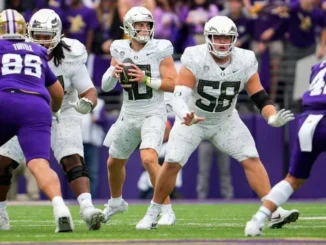
It is finally happening. After all the talk and debate and constant questions over whether it would hurt or help the sport, an expansion to the College Football Playoff has been approved. The board of managers voted last Friday, and a 12-team expansion was approved during the vote.
“There are still quite a few issues that have to be resolved — some very obvious logistical issues that have to be resolved — but our hope is that we can get [the commissioners]to move on this as quickly as it is possible to do so,” said Mississippi State president Mark Keenum, chair of the CFP’s board of managers.
Of course, the current setup is just four teams that make the CFP. Historically, those teams have been consistently Alabama, Georgia, Clemson, Ohio State, and Oklahoma. There are certainly pros and cons to this new 12-team format that will supposedly go into place during the 2026 season but is being pushed for as soon as the 2024 season.
According to ESPN, the format will be as follows:
“The four highest-ranked conference champions will be seeded one through four with each receiving a first-round bye. Teams seeded five through 12 will play each other in the first round on either the second or third weekend of December. The quarterfinals and semifinals will be played in bowl games on a rotating basis, and the championship game will be at a neutral site, as under the current four-team format.”
The big question on all sports fans’ minds is, “How does this impact my team?” And while many fans around the country really won’t have to even worry about their teams being good enough to be considered a Top-12 program, it could impact many that have been on the bubble in years past.
Gone are the days when schools like Texas A&M, Florida, Oregon, USC, Washington, Michigan, Michigan State, Wisconsin, Oklahoma State, and Notre Dame could complain about being left out of the playoff even though they handed in pretty good seasons.
Let’s break this down for Oregon. The expanded playoff is exactly what the Ducks and their school presidents want. The Athletic researched which schools would have made the playoff if this had begun in 1998. The Ducks, unsurprisingly, would have made it ten different times since then in 2000, 2001, 2005, 2009, 2010, 2011, 2012, 2013, 2014, and 2019.
Can you imagine if the Ducks would have played for a National Title in 10 different seasons over the last 22 years? This is the ideal scenario for a program like Oregon, especially considering everything that is up in the air with conference realignment.
If the Ducks can turn in a one-loss season, even in a weak Pac-12, they should be a top-12 team and should have a path to this new playoff.
Let’s break this down from Oregon State. Practically nothing changes. In that same research done by The Athletic, the Beavers would have actually made the playoff one single time. It would have come back during the 2000 season, a year Oregon would have also made it.
There is no indication that Oregon State has done anything special enough to make this playoff in the future, so nothing changes. However, more big-name schools may start scheduling the Beavers earlier in the year.
The reason is that these teams no longer want to risk a loss to another non-conference powerhouse early in the season. Look at what happened to Oregon against Georgia last week. That loss could be the difference in what would be a 12-man playoff. So instead of, say, Georgia or LSU or Ohio State scheduling a game against Oregon, they will gladly schedule that game against Oregon State now.
The Pac-12 is a conference as a whole that will benefit from this, and ESPN reported that sentiment as well.
“The Pac-12 is strongly in favor of CFP expansion and welcomes the decision of the CFP Board,” the Pac-12 said in a statement Friday. “CP expansion will provide increased access and excitement and is the right thing for our student-athletes and fans. We look forward to working with our fellow conferences to finalize the important elements of an expanded CFP in order to launch as soon as practicable.”
There could be some other benefits for a school like Oregon State or maybe even Washington State that have yet to come to light. The main question I have is what happens to all these small-time bowl games that don’t necessarily mean anything now. Do they get elevated to the CFP? Do we add more bowl games to take their spots? With so many unknowns still dangling in the air, I think the questions we have will just have to wait until we see the full blueprint for this.
Some will say that Alabama and Clemson are still going to dominate regardless. Some will say this is just a TV grab. Some will argue the other point that a Cinderella team could finally pull off an incredible upset in college football because they have the chance.
There are pros and cons from both sides of the aisle. What we know for now is that this is excellent news for the Oregon Ducks and just another thing that Oregon State can likely ignore until we know more.



